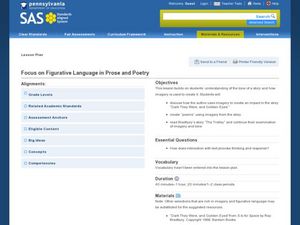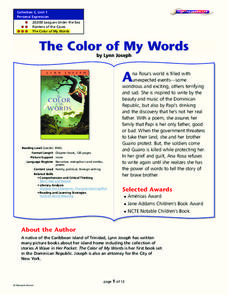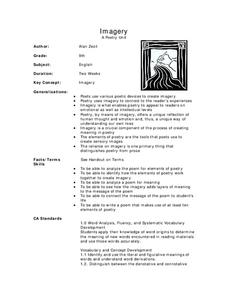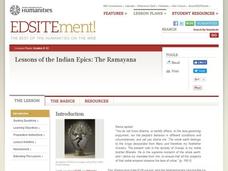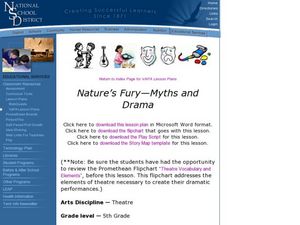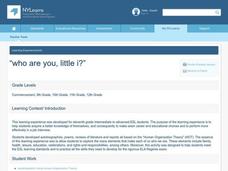Curated OER
Focus on Figurative Language in Prose and Poetry
Students place emphasis on the use of figurative language when analyzing prose and poetry. In this figurative language lesson plan, students explore the tone of a story and its imagery. Students read and discuss how the author uses...
Curated OER
Practicing Literary Analysis
Ninth graders analyze the poem, "The Rime of the Ancient Mariner." They read, discuss, and critique the poem in small groups focusing on plot and figurative language. They compose a short essay explaining how various literary elements...
Curated OER
Look in the Mythic Mirror: I've Got Rhythm!
Learners explore the relationships between music, poetry, and visual art. Using the story of Orpheus and Eurydice, pupils develop an awareness of the compositional elements of the Classical style, and the aesthetic effects of those...
Curated OER
The Color of My Words
Explore the story The Color of My Words by Lynn Joseph using this resource. Learners answer comprehension questions, fill in graphic organizers, and write a poem.
Curated OER
The Poet's Message-"The Colored Soldier" by Langston Hughes
Students analyze the poem, "The Colored Soldier" by Langston Hughes to gain a greater experience of how poets use language to create meaning, influence thinking and thus become pioneers of change in American society. They work on the...
Curated OER
Analyzing Literary Devices
Eighth graders identify figurative language and poetry in this literary analysis instructional activity. Using Through the Looking Glass by Lewis Carroll and a YouTube video for "The Walrus and the Carpenter," young readers complete a...
Curated OER
A PICTURE IS WORTH A THOUSAND WORDS
Students compare and contrast characters from various texts and compile the collected data into several graphic organizers.
Curated OER
"O Captain! My Captain!"
Who was Walt Whitman, and what link does he have to president Abraham Lincoln? After Lincoln's assassination, Whitman wrote "O Captain! My Captain!" This poem and "When Lilacs Last in the Dooryard Bloom'd" are the focus of...
Speak Truth to Power
Harry Wu: Forced Labor
Over the course of two class periods, young historians explore human rights issues; specifically, forced labor in China. This resource provides everything you need, including relevant vocabulary, an anticipatory activity, and a...
Curated OER
Figurative Language
What is figurative language, and why do we use it? Introduce your high schoolers to some examples and discuss the importance of including this element in your writing. After studying a text and searching for examples, writers will...
Curated OER
Preparation -- The Right Way to Help and FOrm for Poetic Reflection
Learners prepare for their service learning project by listening to a representative from the Lake Michigan Federation. They volunteer their time to clean up the coast line. They reflect on the event by writing a poem about their...
Curated OER
Imagery
Ninth graders explore poems, various poetic devices, and identify imagery used in poetry. In groups, they examine poetic devices, define them, paraphrase and summarize poetry. Students study poetry by Robert Frost as they explore...
Curated OER
Lessons of the Indian Epics: The Ramayana
Students read a version of Ramayana and explore the elements of the epic hero cycle. In this Ramayana analysis lesson plan, students retell the basic narrative of the Ramayana and identify the main characters. Students identify elements...
Curated OER
Lost Lyrics of Love, Lust, and Losers
Twelfth graders explore the connection between poetry and the "real world". They are reminded of the elements used in poetic interpretation, and use them to analyze various texts.
Curated OER
Nature’s Fury—Myths and Drama
Fifth graders explore the elements of theatre. In this dramatic performances lesson, 5th graders discuss the structural elements of theatre and dramatize "The Origins of the Season," an explanation myth.
Curated OER
Exploring Photographs, Lesson 2—A Closer Look: Analysis in the Museum
Students explore photographic works of art. In this visual arts lesson, students analyze selected photographs by Garcia, Ray, and Eggleston. Students take their own photographs in the style of these photographers.
Curated OER
Rudyard Kipling's "Rikki-Tikki-Tavi": Mixing Fact and Fiction
"Rikki-Tikki-Tavi," from The Jungle Book, offers young readers a chance to examine how Rudyard Kipling uses setting and personification to bring to life the brave mongoose who battles cobras to protect his family. Class members...
Curated OER
Focus on Figurative Language
Using the poems "First Snow" by Ted Kooser and "Eating Alone" by Yi-Young Lee (or other suggested poems by Robert Frost or Sara Teasdale), middle schoolers search for examples of figurative language. Guide your learners by discussing...
Curated OER
Jazz in America
Students learn the basic elements of music and gain an understanding of the elements found in Jazz.
Curated OER
Acting Like a Bunch of Animals: Fables and Human
The video "The Tales of Aesop" traces for viewers the history of fables and identifies their characteristics. The class then goes to the web site "The Fisherman and the Little Fish" where they examine the classic and a modern version of...
Curated OER
Primary Sources and Protagonists: A Native American Literature Unit
Introduce your middle schoolers to the lives of past Native Americans. First, learners work together to put photographs in a sequence. Then, using their sequence, they create stories to share with the whole class. No matter how old your...
Maryland Department of Education
The Concept of Identity Lesson 2: The Historical/Biographical Approach
"How does our environment shape our identity?" After researching biographical information about John Knowles and considering how these experiences are reflected in A Separate Peace, class members consider the strengths and weaknesses of...
Curated OER
A Prelude To Beowulf
Students study the literature and literary techniques of the early Middle Ages, thus preparing students to read Beowulf with an appreciation for its artistry and beauty. Students solve online riddles, write riddles and study Anglo-Saxon...
Curated OER
Who Are You?
Students explore the concept of self and analyze the Human Organization Theory. Individually, students write poems about themselves. In small groups, they create a poster related to the 14 categories of the Human Organization Theory....
